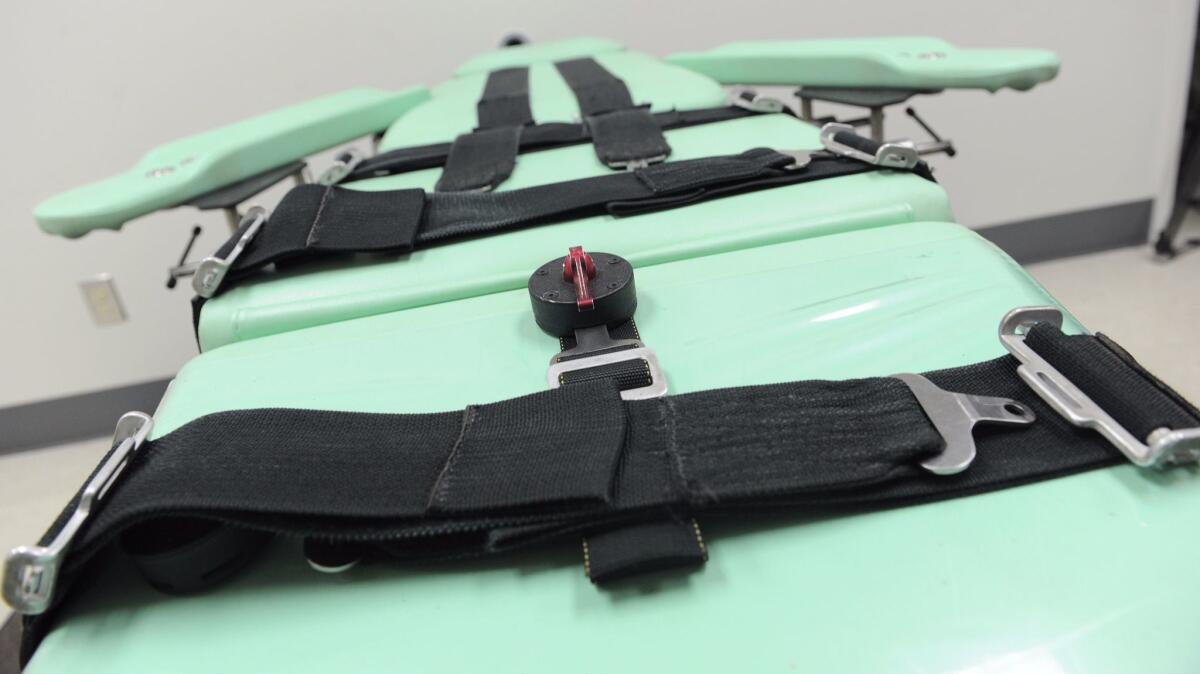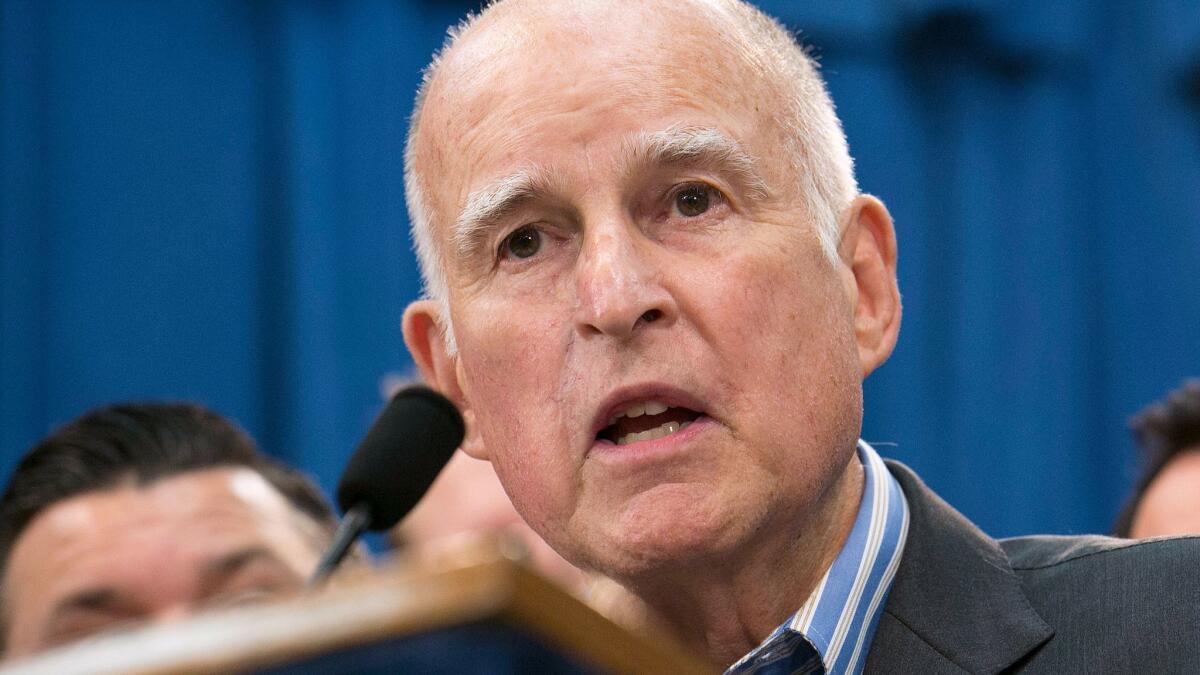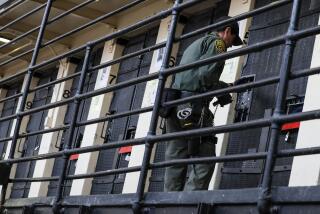Pace of executions in California may be up to Gov. Jerry Brown

When the California Supreme Court upheld a voter initiative in August to speed up executions, some death penalty advocates assumed lethal injections would resume before the end of the year.
Three months after the court’s action, both backers and opponents of the death penalty concede that executions might be more than a year away.
Gov. Jerry Brown’s administration has yet to finalize an execution protocol, which is necessary to resolve a federal court case that has blocked lethal injection in California for nearly 12 years. An injunction stopping executions also is pending in state court.
“Brown is the shot caller” in the litigation over lethal injection, said Michele Hanisee, president of the Assn. of Deputy District Attorneys for L.A. County.
Hanisee expects the state to finalize a lethal injection protocol by January, but if Brown “doesn’t want it to move forward quickly, it won’t move forward quickly,” she said.
Although no one can now predict when executions will resume, UC Berkeley law school Dean Erwin Chemerinsky said “it is just a matter of time.”
“The uncertainty in all of this,” he added, “is what will Jerry Brown do.”

Brown personally opposes the death penalty but enforced it as attorney general. He took no position on two recent and unsuccessful ballot measures that would have ended the death penalty.
Chemerinsky and other lawyers said it was conceivable that Brown and defense lawyers could delay executions until Brown steps down as governor in January 2019.
Brown also could try to commute death sentences to life without parole, but his power is limited by the California Constitution.
Unlike former Illinois Gov. George Ryan, who just before leaving office in 2003 commuted the death sentences of all of Illinois’ condemned inmates, Brown would need the support of the state Supreme Court to spare inmates with multiple felonies on their records.
Lawyers estimate that at least half of all death-row inmates have committed two felonies. The governor would need the support of four of the seven California high court justices to commute those inmates’ sentences.
Brown has three appointees on the court and a fourth vacancy to fill. But whether his appointees would support commutations is questionable.
Two of them — Justices Goodwin Liu and Mariano-Florentino Cuéllar — are moderately liberal, but Justice Leondra Kruger, the third, has voted with conservatives on criminal justice issues.
Ronald Reagan was the last California governor to commute a death sentence, deciding in 1967 to move Calvin Thomas off death row because Thomas had serious brain damage.
Under former Gov. Pat Brown, Jerry Brown’s father, 35 death row inmates were executed. The elder Brown commuted the capital sentences of 20 others.
Among the most famous executions under Pat Brown’s watch was that of Caryl Chessman, convicted of robbery, sexual assaults and kidnapping. He was sentenced to death under a law, later repealed, that made certain kidnappings capital offenses.
Chessman, who represented himself at trial, wrote four books on death row and attracted international sympathy. The elder Brown tried to commute Chessman’s sentence, but the California Supreme Court refused to go along, on a 4 to 3 vote.
Jerry Brown has never faced the wrenching decisions that confronted his father over executions, and the issue also is new for Atty. Gen. Xavier Becerra, appointed by Brown after Kamala Harris was elected to the U.S. Senate.
Becerra, now the top law enforcement officer in California, has testified that he supports the death penalty, but not “the way it is being executed,” and would enforce Proposition 66, the execution speed-up measure largely upheld by the state supreme court in August.
Becerra also has said he would run for election to continue as attorney general.
Prosecutors are expected to press Becerra to move quickly to overturn the injunctions preventing executions, but his role is to represent Brown’s Department of Corrections and Rehabilitation in the case, a Becerra press aide said.
Prosecutors, who sponsored Proposition 66, and crime victims also are considering trying to intervene in the two court cases preventing executions.
Initiative sponsors generally have standing in state court to defend ballot measures, but obtaining entry into a federal court case is more difficult.
U.S. District Judge Richard Seeborg, an Obama appointee who is now presiding over the Northern California federal case that stopped California from executing, could allow crime victims or Proposition 66 sponsors to intervene, but he is not required to do so by law, said Chemerinsky, the Berkeley law school dean.
“There is no enthusiasm inside the administration to do anything” to hasten executions, said Michael D. Rushford, the founder and top executive of the Criminal Justice Legal Foundation, a conservative nonprofit that helped write Proposition 66.
Voters narrowly approved the measure a year ago. The state Supreme Court ruling that permitted its enforcement became final only a few weeks ago, delayed by an unsuccessful request from challengers for the court to reconsider.
“There are laws in this state that if the administration doesn’t want to enforce, they don’t,” Rushford said, “and this is one of them.”
Rushford’s group sued to force the Brown administration to produce a single-drug lethal injection method, which has not yet been made final, and has warned it would sue the administration again if it does not move toward executions.
There are about 18 inmates who could immediately be executed because they have no appeals left. But these inmates have obtained federal stays to prevent their executions until the lethal injection case overseen by Seeborg is concluded.
For the stays to be lifted, Seeborg would have to decide that California’s new single-drug method of execution, once finalized, did not violate the U.S. Constitution’s ban on cruel and unusual punishment. Whatever he decides could then be appealed.
Legal precedent favors those who want executions.
The U.S. Supreme Court handed down a 5-4 decision in 2015 that makes it difficult for inmates to successfully challenge lethal injection methods.
Brown’s press office referred questions about executions and possible commutations to the Department of Corrections and Rehabilitation, which said it was revising a lethal injection protocol but declined to estimate how long that might take.
Ana Zamora, a policy director of the ACLU of Northern California, said she does not expect executions to resume soon.
“The D.A.s and the proponents of Prop. 66 really sold voters a false bill of good,” she said. “Nothing has changed. There are still significant problems around lethal injection, and those are not going to go away anytime soon.”
The ACLU opposes the death penalty, but even some supporters have little faith that the state will reopen the execution chamber anytime soon.
It’s as if we’re all performers in a Gilbert and Sullivan operetta.
— U.S. appeals court Judge Alex Kozinski, describing the state’s inaction in reinstating the death penalty.
U.S. 9th Circuit Court of Appeals Judge Alex Kozinski, a Reagan appointee who supports the death penalty, wrote in October that California “has no functional death penalty,” despite the law to speed up executions and the fact that the state’s death row, with nearly 750 inmates, is the largest in the Western Hemisphere.
California has failed to “come up with a workable protocol” for executions for more than 10 years, Kozinski wrote.
“It’s as if we’re all performers in a Gilbert and Sullivan operetta,” the judge said. “We make exaggerated gestures and generate much fanfare. But in the end it amounts to nothing.”
Twitter: @mauradolan
More to Read
Sign up for Essential California
The most important California stories and recommendations in your inbox every morning.
You may occasionally receive promotional content from the Los Angeles Times.











